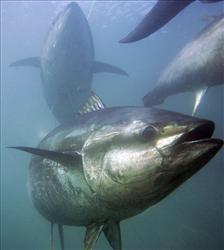
Bluefin tuna that were caught in the waters off San Diego contain high levels of radioactivity that experts believe came from Japan’s decimated nuclear plant, according to the Associated Press.
The fish were contaminated with radiation from the Fukushima nuclear power plant that was destroyed in a tsunami and were still carrying a high amount of radioactivity after swimming 6,000 miles to United States waters.
Normally, a large fish will not remain contaminated after it swims long distances. Blue fin tuna can grow up to 10-feet long and weight over 1,000 lbs.
“We were frankly kind of startled,” Nicholas Fisher, a researcher who reported the findings in the Proceedings of the National Academy of Sciences, was quoted as saying.
Their radioactive cesium levels were reportedly 10 times higher than normal. The levels still fall below the “safe-to-eat” limits set by the American and Japanese governments.
To be sure that the radiation came from the nuclear disaster in Japan and not ocean currents or radiation that had been deposited in the sea through the atmosphere, Fisher and a team of scientists from Stony Brook University examined yellowfin tuna found in the eastern Pacific.
Next they analyzed bluefin tuna that migrated to Southern California from Japan before the tsunami. They did not find the same level of radioactivity contamination.
The results “are unequivocal. Fukushima was the source,” Ken Buesseler of the Woods Hole Oceanographic Institution was quoted as saying. He did not play a role in any of the research.
The scientists believe high levels of radioactive cesium in the bluefin tuna was due to swimming in contaminated waters and eating contaminated food like as krill and squid, according to AP.
When the fish swam east they were able to get rid of some of the contamination through their metabolism, but they were not able to release all the contamination from their system.
“That’s a big ocean. To swim across it and still retain these radionuclides is pretty amazing,” Fisher said.

































